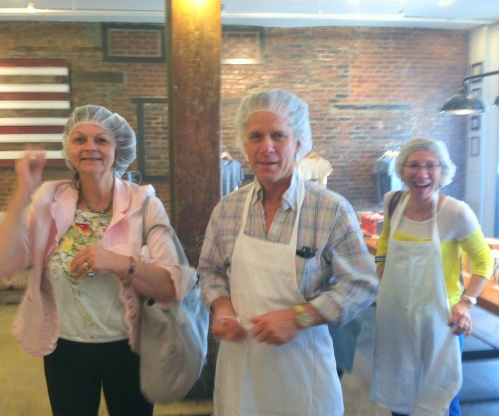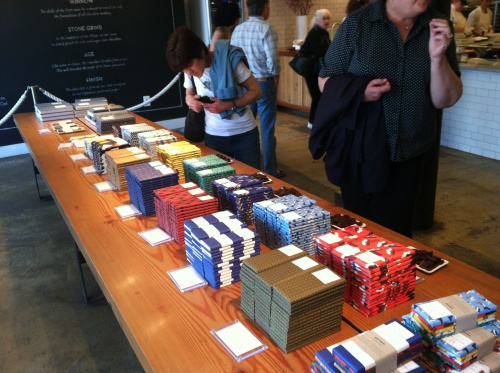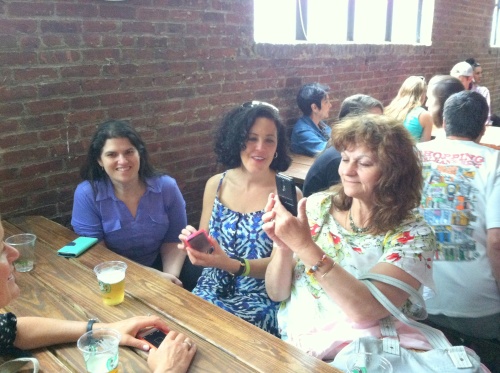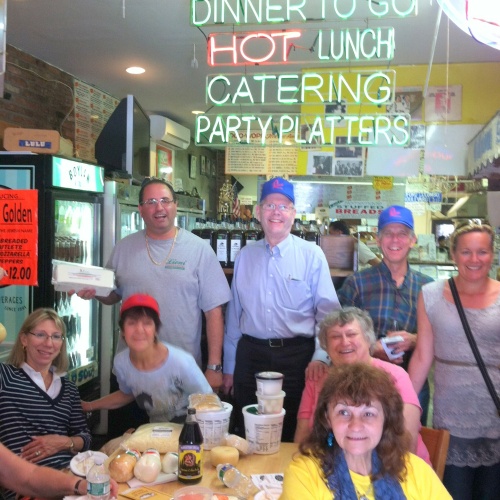Culinary Weekend in Brooklyn, New York
Recently, The Culinary Guild of New England took a culinary tour of Brooklyn, New York. Here, CGNE member Isabel Chesak recounts all of the delicious eats, fantastic sights and interesting history we took in over our three-day stay there.
Brooklyn is so alive! Here in Williamsburg, every block seems to offer some interesting restaurant, sight or shop. Everything excites my curiosity!
I have arrived here with friends from The Culinary Guild of New England on a Friday afternoon, and our first destination is Buttermilk Channel in Carroll Gardens for dinner. It is a loud and hopping place with a butcher-block bar and a communal table. Conversation is difficult, but the atmosphere is colorful and inviting. Buttermilk Channel is supposedly named for a channel where dairy farmers used to drive their cattle across at low tide. It is said the waters in those days were so rough that the cows’ milk used to churn to buttermilk. Nobody seems to know the truth of the restaurant’s name, but it is certainly respected for its crisp and crunchy buttermilk fried chicken. I, however, am more interested in the grilled flatbread with its house-made buttermilk ricotta and in the succulent and briny oysters. I follow these with an entree of a parsley-crusted New England hake with fresh shelling beans and rainbow chard in an orange blossom broth with chili oil. It proves to be an excellent choice.
Breakfast the next morning is at Egg. This Southern and soul food establishment is enticing with its tater tots and southern-style biscuits. The veggies come from the restaurant’s own garden, and a popular item on the menu is the crispy duck hash where a seared duck leg, home fries and crispy green onions are smeared into a mash-up crowned with a softly cooked egg.
After breakfast we go next door to Mast Brothers Chocolate. As we enter the facility, the smell of melting chocolate is heady. I can almost taste it! We are given a tour of this brightly lit establishment where the chocolates are made using only cacao beans and sugar. After watching the chocolate production, from the bean to the final product, five different chocolates of various tastes and of different origins are offered to us. Each has a different flavor – the flavor is a result of the soil at the origin of the chocolate (there are no additional flavorings added). My favorite was the dark chocolate with sea salt and almonds made with Madagascar cacao.
Following our tour of Mast Brothers, our Williamsburg guides, Liz Pavese and Neil Piat, proceed to show us the funky boutiques and vintage clothing stores of Williamsburg’s Grand Street. This hip community with its backdrop of old industrial buildings has been home to old Jewish and Italian families for many years.
After poking around in various eclectic shops, we tour the Brooklyn Brewery where we are refreshed with a welcome stein of Hefeweizen beer and learn some of the traditions of this popular brewery. Williamsburg, a haven for immigrants in the 19th century, had a vigorous tradition for beer brewing due to its extensive German population. The Germans have always had stringent beer codes of using only hops, wheat, barley, yeast and water in their productions, and although this tradition died out in the middle of the 20th century, Brooklyn Brewery has managed to reignite the culture of beer brewing. During the 19th century, it was not unusual to see children making their way home in the early evenings with pails of beer for their overworked parents. These pails were termed “growlers.” The brewery likes to use this term when describing their various mugs of beer.
Later it’s on to Brooklyn Flea and Smorgasburg. The latter is a gigantic market of food carts producing decadent edible treats, a real locavore food festival. There are fiery tacos, fresh sausages, homemade pimento cheeses, bagels and breads, brisket with chili and cornbread, Asian and Indian temptations, and other tasty treats.
That evening we have dinner at Glasserie in Greenpoint. This former glassworks was significant during the 19th century for its celebrated cut glass. The walls of the restaurant are decorated with prints from the glassworks’ 19th century catalogues. Because Glasserie is noted for its large rustic suppers, I order the chicken with snow peas and pistachios. This is delicious, but prior to that we feast on griddled bread served with labneh (yogurt cheese) as well as tahini, hummus and harissa (a picante Middle Eastern condiment).
We end our evening by viewing the film “Chef,” a story of a washed-out father who finally makes his mark by opening up a food truck where he is able to spread his culinary “wings.”
The following day, we tour Bensonhurst with our guide Dom Gervasi of Made in Brooklyn Tours. Our first stop is Villabate Alba where we are treated to shatteringly crisp cannoli filled with fresh ricotta from Palermo – a great beginning to our tour. There are also sfogliatelli and Sicilian pastries creamy with marzipan.
At Pastosa Ravioli, we enjoy watching the white-clothed workers, pulling and stretching the dough in huge pasta machines. The flavors are endless. There is spinach pasta, lobster pasta, pasta made with squid ink, with tomatoes, pumpkin etc.
Afterwards, in the shop of Lioni Italian Heroes, we marvel at the assortment of imported Italian olive oils, pastas, specialty meats and other prepared foods. Lioni offers over 150 types of hero sandwiches all named after famous Italians and Italian-Americans. In the shop, we are tempted to buy fresh artisanal prosciutto, roasted peppers, extra virgin olive oil and fresh breads. Before we leave, we are each given a full-size ball of the shop’s creamy mozzarella.
Later we visit Panino Rustico, where platters are overloaded with sumptuous Italian panini. One is of sopressata, tomato and arugula, and another of grilled chicken, fresh mozzarella, roasted peppers and basil pesto.
Our visit concludes with a stop at the New Utrecht Reformed Church, which was organized by Dutch colonists in 1677. Among the settlers who used to worship here were members of the Benson family, buried in the church cemetery for whom this area is named.
Touring this area has really been a trip back in time as the neighborhood is a memory walk through a bubble of the past. It is a reminder of an Italian neighborhood of the 60’s and 70’s not unlike the one where I grew up. I treasure the historical and gastronomic adventures that I have had in Brooklyn. It is a colorful, vibrant, eclectic area that I encourage everybody to visit.
*Photos courtesy of Kris Piatt, CGNE President.




